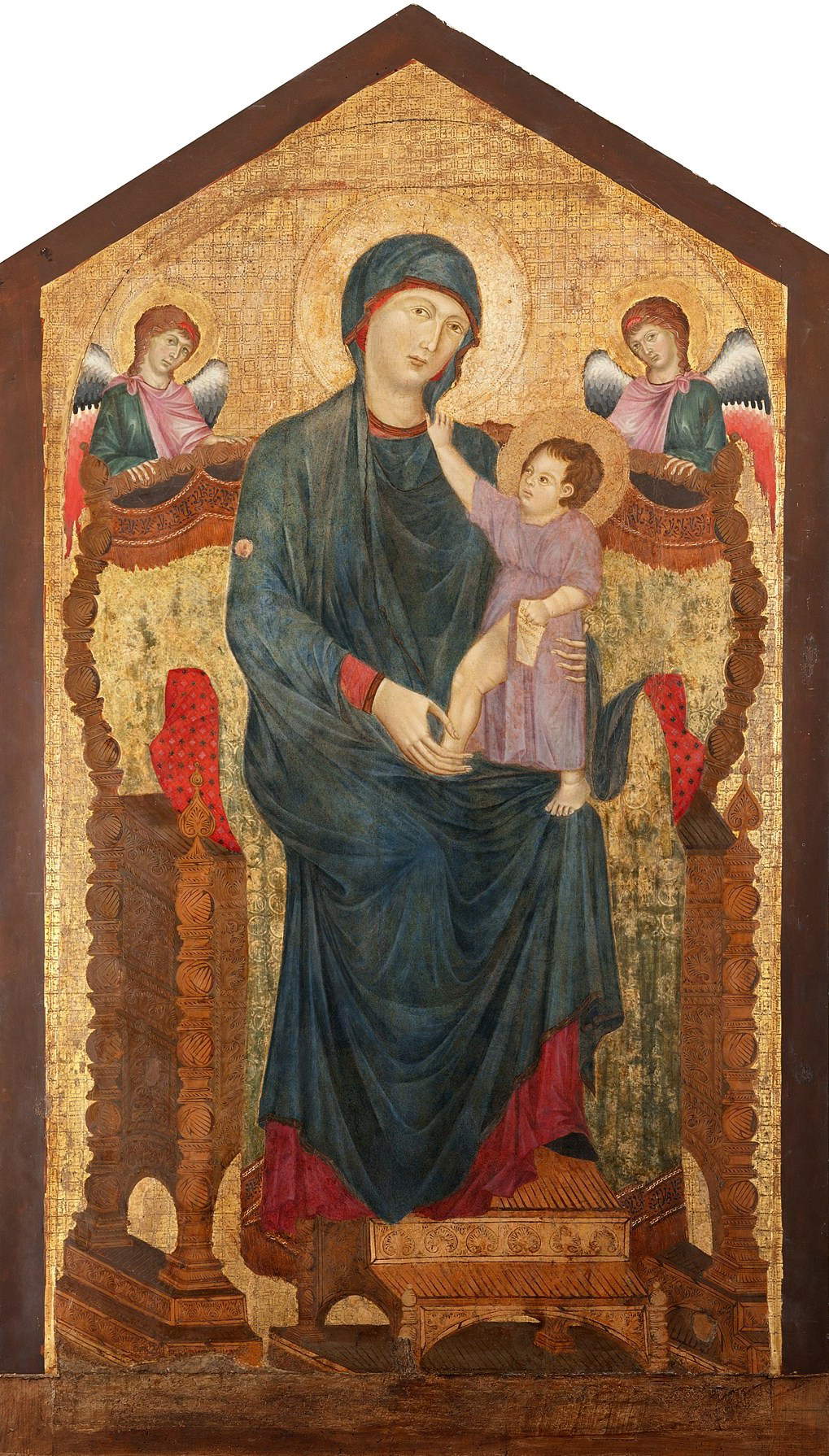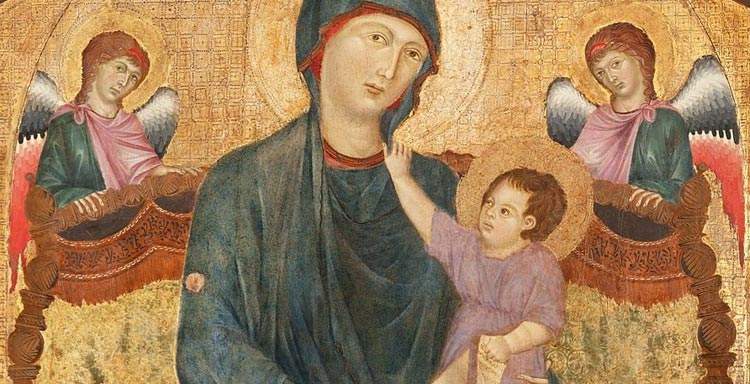The uncertainty in accepting the attribution to Cimabue, proposed by Thode for the work never remembered in the sources and lacking any documentation, was mainly due to the state of preservation that allowed only to guess at it not to fully evaluate its artistic factors. Yes that even when that authorship had been accepted, the problem of chronology had only been able to be set on the basis of external iconographic considerations. The compositional scheme of the Madonna dei Servi, with the two angels behind the back of the throne, the one already favored by Coppo di Marcovaldo, but by then outmoded in Florence in the late thirteenth century, had led some scholars to consider it a youthful work, earlier than the Madonnas of Santa Trinita (now in the Uffizi), the Louvre, the lower church in Assisi, more complex in composition, and Sirèn, exaggerating this tendency, even speaks of a work not far removed in age from Coppo’s Madonnas, or even executed by Cimabue in a hypothetical apprenticeship with this artist.
But now other elements have come to light to resolve such questions. The form, first of all, no longer weak, empty, as the repainting made it appear, but broad, strongly plastic. Now, even in the thinning of the color, there appears the profound plastic relationship between the brightness of the salient parts and the somber intensity of the deepening, the infinite graduation of chiaroscuro planes in the sculptural folds that follow one another from the party on the chest to that between the knees to widen in the great flap falling to the left in a clear rhythmic solemnity almost exemplified in classical sculpture.

And the color now appears in the genuine clarity of its tones, but also in the intensity of its luminous value, the maximum coefficient of that plastic effect. It intensifies as a gradation from the ochre of the tone, through the soft green of the drape over it, to the deep ultramarine of the mantle. And around these essential chromatic masses, the ringing notes in the multicolored wings of the angels at the sides, in their rosy coats, in the two vermilion flaps of the cushion, in the carmine of the robe at the bottom, are arranged almost in vivid halo, compendiuming in the center every luminous value in the transparent purple of the Child.
This very balanced chromatic construction is at one with the plastic effect, for it is all permeated with light, graduated in its intensities by a precise will to mark even through color the depth and continuity of space. It is no longer the decorative juxtaposition of tones to which Romanesque painting, dominant in Florence until the late thirteenth century, had reduced the plastic suggestions of Byzantine painting. Those suggestions are now understood with full consciousness: it is now known that the third dimension, where the volume of bodies is defined, no longer unrealized in fantasy, but exalted in their real consistency, is achieved by graduating throughout, in continuity, the luminous intensities. This is what will be intended by Giotto, but also turned by him to different ends. In Giotto - and it is well seen in the Uffizi Madonna - a powerful architectural abstraction dominates form and space. The chromatic masses are defined, yes, by intense graduation of light, but immobilized, petrified now in an architectural rhythm outside all reality. Color is not in him an environmental vibration: it seems solid matter to individual volumes. The tones almost juxtapose to single them out, in the superhuman meter that creates to new form and space. Here, on the other hand, plasticity is in the making, arising from the whole pictorial environment.
The masses are not enclosed in symbolic, immobile abstraction, but seem to reveal themselves, surfacing from unreal distances, in a light for all diffuse. This vigorous plasticist brought back to the interior of the color that light which his Byzantine masters had unrealistically radiated on the surfaces, a precious commentary on the preciousness of the tones. He made it the highest factor in his sculptural will. But, still mindful of that Byzantine splendor, he has also dispersed it everywhere, in the atmosphere in which his forms live. It vibrates, luminous reverberation, on the drape of the throne with its embroidery, on the veils of the Child, on the hem of the Virgin’s robe. It is an ambient sense of color and light, a continuous plastic-luminous movement, different from Giotto’s motionless geometry. But one cannot imagine that geometry without the assumption of this powerful reassertion of the plastic sense in the midst of the decorative, still Romanesque tendencies of Dugentine painting, especially in Florence. And this appears with such analogous consciousness, and with such analogous choice of expressive means, in the Madonnas of Santa Trinita, of the Louvre, of Assisi, and in that of the Servants, as to lead us to consider all these works the product of a single artistic will. Even if the full demonstration of this requires more extensive comparisons, more intimate definition of Cimabue’s work than a restoration report allows.
---
Luisa Becherucci, Il restauro della ’Madonna dei Servi’ a Bologna, in Bollettino d’Arte, XXXI, I (July 1937), pp. 14-16
 |
| Supercult. Luisa Becherucci on Cimabue |
Warning: the translation into English of the original Italian article was created using automatic tools. We undertake to review all articles, but we do not guarantee the total absence of inaccuracies in the translation due to the program. You can find the original by clicking on the ITA button. If you find any mistake,please contact us.